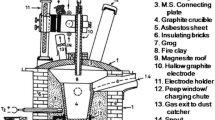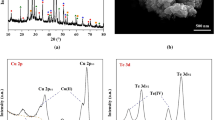Abstract
Due to the wide applications, limited supply, and high demand, sustainable utilization of indium has become an important task. In this study, the recovery of indium from acidic extractant solutions of ITO scraps using aluminum (Al) powder was investigated. The cementation reaction of indium from HCl solution was completed within 10 min and it could be described by pseudo-first-order kinetic model. Effective recovery of indium (91.69%) at aluminum dose of 5 g/L and 25 °C was found in HCl solution. Recovery efficiency increased with aluminum dose. Results from cyclic voltammetry were used to provide information why cementation reactions did not work in H2SO4 or HNO3 solutions. Indium recovery by aluminum cementation could be an alternative process, which is simple and efficient. However, there are some drawbacks, e.g., cementation reaction was not specific as tin was recovered simultaneously with indium from solutions. Furthermore, removal and separation of indium deposit on aluminum surfaces could be another issue.




Similar content being viewed by others
References
Kumar A, Holuszko M, Crocce D, Espinosa R (2017) E-waste: An overview on generation, collection, legislation and recycling practices. Resour Conserv Recyc 122:32–42
Buekens A, Yang J (2014) Recycling of WEEE plastics: a review. J Mater Cycles Waste Manag 16:415–434
Balde CP, Forti V, Gray V, Kuehr R, Stegman P (2017) The global E-waste monitor 2017: quantities, flows, and resources. United Nations University (UNU), International Telecommunication Union (ITU) & International Solid Waste Association (ISWA), Bonn
Cucchiella F, D’Adamo I, Koh SCL, Rosa P (2015) Recycling of WEEEs: An economic assessment of present and future e-waste streams. Renew Sustain Energy Rev 51:263–272
Ferella F, Belardi G, Marsilii A, Michelis ID, Veglio E (2017) Separation and recovery of glass, plastic and indium from spent LCD panels. Waste Manag 60:569–581
Filella M, Rodriguez-Murillo JC (2017) Less-studied TCE: are their environmental concentrations increasing due to their use in new technologies? Chemosphere 182:605–616
Frenzel M, Mikolajeczak C, Reuter MA, Gutzmer J (2017) Quantifying the relative availability of high-tech by-product metals—the cases of gallium, germanium, and indium. Resour Policy 52:327–335
Supanchaiyamat N, Hunt A (2019) Conservation of critical elements of the periodic table. Chemsuschem 12:397–403
Rocchetti L, Amato A, Fonti V, Ubaldini S, De Michelis I, Kopacek B, Veglio F, Beolchini F (2015) Cross-current leaching of indium from end-of-life LCD panels. Waste Manag 42:180–187
Zhang K, Wu Y, Wang W, Li B, Zhang Y, Zuo T (2015) Recycling indium from waste LCDs: a review. Resour Conserv Recyc 104:276–290
Argenta AB, Reis CM, Mello GP, Dotto GL, Tanabe EH, Bertuol DA (2017) Supercritical CO2 extraction of indium present in liquid crystal displays from discarded cell phones using organic acids. J Supercrit Fluid 120:95–101
Zhang K, Li B, Wu Y, Wang W, Li R, Zhang YN, Zuo T (2017) Recycling of indium from waste LCD: a promising non-crushing leaching with the aid of ultrasonic wave. Waste Manag 64:236–243
Souada M, Louage C, Doisy JY, Meuner L, Benderrag A, Ouddane B, Bellayer S, Nuns N, Traisnel M, Maschke U (2018) Extraction of indium-tin oxide from end-of-life LCD panels using ultrasound assisted acid leaching. Ultrason Sonochem 40:929–936
Lee CH, Jeong MK, Kilicaslan MF, Lee JH, Hong HS, Hong SJ (2013) Recovery of indium from used LCD panel by a time efficient and environmentally sound method assisted HEBM. Waste Manag 33:730–734
Yoshida H, Izhar S, Nishio E, Utsumi Y, Kakimori N, Asghari FS (2015) Recovery of indium from TFT and CF glasses of LCD wastes using NaOH-enhanced sub-critical water. J Supercrit Fluids 104:40–48
Rahmawati A, Liu JC (2019) Indium extraction from indium tin oxide (ITO) scraps using subcritical water. Desalin Water Treat 137:69–75
Yang J, Retegan T, Steenari BM, Ekberg C (2014) Recovery of indium and yttrium from flat panel display waste using solvent extraction. Sep Purif Technol 268:185–190
Chou W, Shen Y, Yang S, Hsiao T, Huang L (2016) Recovery of indium from the etching solution of indium tin oxide by solvent extraction. Environ Prog Sust Energy 35:758–763
Deferm C, Van de Voorde M, Luyte J, Oosterhof H, Fransaer J, Binnemans K (2016) Purification of indium by solvent extraction with undiluted ionic liquids. Green Chem 18:4116–4127
Assefi M, Maroufi S, Nekouei RK, Sahajwalla V (2018) Selective recovery of indium from scrap LCD panels using macroporous resins. J Clean Prod 180:814–822
Rocchetti L, Amato A, Beolchini F (2016) Recovery of indium from liquid crystal displays. J Clean Prod 116:299–305
Asadrokht M, Zakeri A (2018) Effect of ball milling on cementation reactions: the case of Cu–Al system. Miner Eng 125:15–25
Karavasteva M (2014) The effect of magnesium and zinc on indium cementation kinetics and deposit morphology in the presence of and without nonylphenylpolyethylene glycol. Hydrometallurgy 150:47–51
Gustafsson AMK, Bjorefors F, Steenari BM, Ekberg C (2015) Investigation of an electrochemical method for separation of copper, indium, and gallium from pretreated CIGS solar cell waste materials. Sci World J 2015:1–11
Armstrong DA, Huei RE, Koppenol WH, Lymar SV, Marenyi G, Neta P, Ruscic B, Stanbury DM, Steenken S, Wardman P (2015) Standard electrode potentials involving radicals in aqueous solution: inorganic radicals (IUPAC Technical Report). Pure Appl Chem 87:1140–1150
Wolterink A, Kim S, Muusse M, Kim IS, Roholl PJ, Van Ginkel CG, Stams AJ, Kengen SW (2015) Dechloromonas hortensis sp. nov. and strain ASK-1, two novel (per)chlorate-reducing bacteria, and taxonomic description of strain GR-1. Int J Syst Evol Microbiol 55:2063–2068
Jiang J, Liang D, Zhong Q (2011) Precipitation of indium using sodium tripolyphosphate. Hydrometallurgy 106:165–169
Li Y, Liu Z, Li Q, Liu Z, Zeng L (2011) Recovery of indium from used indium–tin oxide (ITO) targets. Hydrometallurgy 105:207–212
Park JC (2011) The recovery of indium metal from ITO-scrap using hydrothermal reaction in alkaline solution. Bull Korean Chem 32:3796–3798
Lee S, Kim GH, Ryu SS, Hong HS (2014) Recovery of indium powders from indium chloride solutions by cementation. J Can Metall Q 53:232–239
Demirkiran N, Kunkul A (2011) Recovering copper with metallic aluminum. Trans Nonferrous Met Soc China 21:2778–2782
Hibbert DB (1993) Introduction to Electrochemistry. Macmillan, London
Kaifer AE, Kaifer MG (1999) Supramolecular electrochemistry. Wiley-VCH, New York
Author information
Authors and Affiliations
Corresponding author
Additional information
Publisher's Note
Springer Nature remains neutral with regard to jurisdictional claims in published maps and institutional affiliations.
Rights and permissions
About this article
Cite this article
Rahmawati, A., Liu, JC. Recovery of indium from extractants of waste indium tin oxide (ITO) by aluminum cementation. J Mater Cycles Waste Manag 22, 326–332 (2020). https://doi.org/10.1007/s10163-019-00916-3
Received:
Accepted:
Published:
Issue Date:
DOI: https://doi.org/10.1007/s10163-019-00916-3




